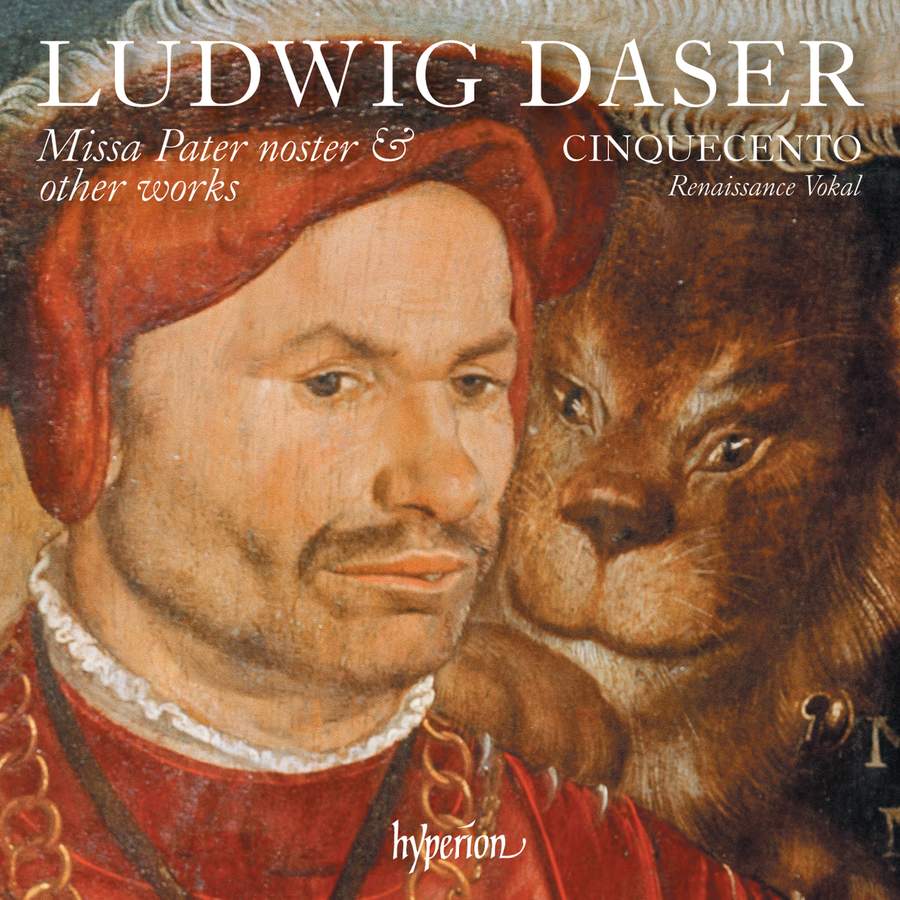DASER Missa Pater Noster & Other Works
View record and artist detailsRecord and Artist Details
Genre:
Vocal
Label: Hyperion
Magazine Review Date: 11/2023
Media Format: CD or Download
Media Runtime: 70
Mastering:
DDD
Catalogue Number: CDA68414

Tracks:
| Composition | Artist Credit |
|---|---|
| Ad te levavi oculos meos |
Ludwig Daser, Composer
Cinquecento |
| Benedictus Dominus |
Ludwig Daser, Composer
Cinquecento |
| Christe, qui lux es et dies |
Ludwig Daser, Composer
Cinquecento |
| Danck sagen wir alle |
Ludwig Daser, Composer
Cinquecento |
| Daran gedenck Jacob und Israel |
Ludwig Daser, Composer
Cinquecento |
| Dilexi, quoniam |
Ludwig Daser, Composer
Cinquecento |
| Fracta diuturnis |
Ludwig Daser, Composer
Cinquecento |
| Fratres, sobrii estote |
Ludwig Daser, Composer
Cinquecento |
| Missa Pater noster |
Ludwig Daser, Composer
Cinquecento |
| Salvum me fac |
Ludwig Daser, Composer
Cinquecento |
Author: Fabrice Fitch
It’s been quite the year for Ludwig Daser. Long eclipsed by his predecessor and successor as Kapellmeister at the Bavarian Court (respectively Senfl and Lassus), he’s had two anthologies devoted to him in a matter of months. The first, from the Huelgas Ensemble (DHM, 5/23), was highly praised and won the Early Music category in this year’s Gramophone Awards; this is just as fine.
Conceived on a grand scale, the Missa Pater noster (apparently one of the composer’s last) is most impressive. The eponymous plainchant appears throughout, but is combined in the ‘Credo I’ chant in that movement (a feature of settings of Credo settings dating back to the 15th century) with the Ave Maria plainsong for good measure. This combinatorial approach likewise harks back to the previous century, and to Senfl. Daser hardly lacks either ambition or chops, or a sense of the musical tradition in which he worked. Another fine touch is the series of reduced sections disseminated throughout the work, all scored for a trio of equal voices, first high, then two middle and one low. Among other things, this results in a Kyrie of exceptional size. Monumental in conception, the work is certainly a monument to its creator. The only puzzling feature is Cinquecento’s omission of the ‘Osanna’ after the ‘Pleni’, given that Daser does set one (it is free-standing and is heard after Benedictus); if this omission is prescribed in the source, the introductory notes don’t mention it.
Cinquecento devote considerable space to the next phase of Daser’s career, at the Ducal Court of Baden-Württemberg at Stuttgart, where his emphasis switched to motets and German-texted religious works. The works for double choir have a compelling sonority, especially when delivered by soloists of this quality, but those for just four or five voices are affecting and full of distinctive touches, more personal in affect than the grandeur and solemnity of the Mass. Among the double-choir pieces I especially enjoyed the opening track, Benedictus Dominus, while the seven-voice Fracta diuturnis has some lovely responses to the text; and among the more lightly scored works, Ad te levavi stands out for sheer loveliness.
There is much to praise in these poised, polished performances, hieratic in the Mass and more intimate where the music permits it (the beginning of the ‘Qui tollis’ is lovely in a way that recalls Lassus). Speaking of Daser’s successor, this seems to me to be Cinquecento’s finest disc (in terms of both programming and performance) since the one they devoted to Lassus (8/15). Finally, congratulations on the cover illustration, which juxtaposes the Bavarian Court jester and a lion: it’s a terrific image.
Discover the world's largest classical music catalogue with Presto Music.

Gramophone Digital Club
- Digital Edition
- Digital Archive
- Reviews Database
- Full website access
From £8.75 / month
Subscribe
Gramophone Full Club
- Print Edition
- Digital Edition
- Digital Archive
- Reviews Database
- Full website access
From £11.00 / month
Subscribe
If you are a library, university or other organisation that would be interested in an institutional subscription to Gramophone please click here for further information.




